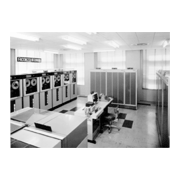Published on Jun. 1, 2006
Last updated on Jul. 8, 2023
This was a transistor-based small general-purpose computer, developed by Fuji Tsushinki Seizo in March 1963. In contrast with previous small computers, which combined a 1-word calculation system with a drum memory system, this machine featured 1-digit calculation (using a variable word length system) and a magnetic core memory (employing 50mil magnetic core memory with a cycle time of 10microseconds). All data was handled in single-digit form, so the arithmetic logic unit and controllers were simplified and price was reduced. The machine achieved a 520/670microseconds arithmetic speed for addition/subtraction (decimal, 10-digit) using a 200KHz basic clock cycle (which was indicated at the time as "200kc"). A variety of configurations could be achieved to suit the application by using the building block structure -- from the paper tape based basic configuration with a memory capacity of 4 Kdigit, to the top-end configuration with devices like magnetic tape and magnetic drum connected, and a maximum memory capacity of 32 Kdigit. The system was used widely in a variety of fields -- for example by mid-size companies to rationalize office work, and by universities for scientific purposes. In 1962, the FACOM 231 was exhibited together with the FACOM 241 at the "1962 Japan Electronic Computer Show", the first general show for Japanese-made computers held in Harumi (Tokyo) in November 1962. It was recommended by the Japanese government as a representative of Japanese-made computers for the New York World's Fair held in 1964-1965, and was displayed in the Japanese Government Pavilion.


